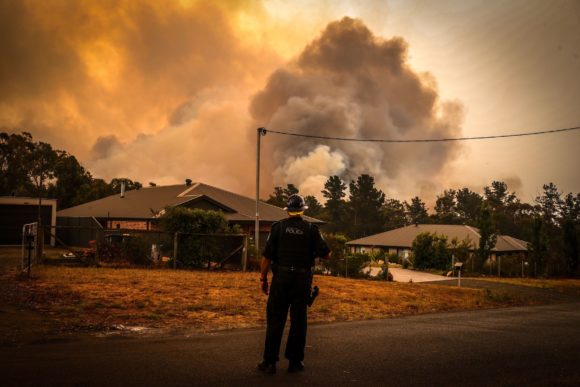Australia’s devastating wildfires, which at the weekend destroyed close to 200 homes and claimed another life, show no sign of abating and are poised to blight Christmas celebrations.
Around 200 blazes were burning across the world’s driest inhabited continent on Monday. New South Wales, the most populous state, remains at the forefront of the disaster with almost 800 houses lost since the fire season began unusually early in the midst of winter. The crisis has spread to South Australia state, where an estimated 86 homes were destroyed at the weekend.
The deteriorating conditions forced Prime Minister Scott Morrison to cancel his family holiday in Hawaii. Returning home at the weekend, he apologized for causing “anxiety” with his unannounced trip, but continued to downplay any link between climate change and the crisis and dismissed calls to take more steps to curb emissions.
Swedish climate change activist Greta Thunberg seized on Australia’s bushfires as another example of a lack of political action, as she retweeted a news report showing ferocious blazes threatening homes.
Australia’s conservative government in 2014 dismantled a carbon trading mechanism that put a price on emissions. Morrison says the nation is on target to meet its Paris Agreement commitments, but at the same time wants to increase sales of coal — the biggest export earner last year.
While Morrison says Australia is responsible for just 1.3% of global emissions, environmentalists and the leaders of some South Pacific nations that are threatened by rising sea levels say that doesn’t take into account its massive fossil-fuel exports, the largest after Russia and Saudi Arabia.
“Australia is taking action on climate change,” Morrison said in a television interview on Monday, labeling calls to further lower carbon emissions as “reckless.”
“What we won’t do is engage in reckless and job-destroying and economy-crunching targets,” he said.
Morrison’s policies have increasingly been in the spotlight during this year’s early and intense wildfire season, with a crippling drought in much of the nation’s east combining with a heatwave in the past week to create conditions deemed “catastrophic” by authorities.
While conditions cooled on Monday, temperatures are forecast to approach 40 degrees Celsius (104 degrees Fahrenheit) in cities such as Adelaide and Canberra by the weekend.
The hills surrounding Adelaide, famous for their wine and cuisine, were the epicenter of the South Australian fires at the weekend, which have caused blackouts to thousands of homes that look likely to stretch into Christmas Day. The death of a man in the state brought the national toll to nine.
In New South Wales, around 100 blazes are burning, and more than 6 million acres have been burnt out in the state. Fires down the coast south of Sydney are closing roads and causing many people to cancel their holiday plans.
The states of Queensland, Victoria and Western Australian have also been hit this fire season, stretching the resources of fire services, which are mainly staffed by unpaid volunteers.
About the photo: A policeman watches bushfires as they approach homes located on the outskirts of the town of Bargo on Saturday in Sydney, Australia. A catastrophic fire danger warning has been issued for the greater Sydney region, the Illawarra and southern ranges as hot, windy conditions continue to hamper firefighting efforts across New South Wales. (Photo by David Gray/Getty Images)
Was this article valuable?
Here are more articles you may enjoy.


 Average U.S. Vehicle Age Approaching 13 Years, New Report Shows
Average U.S. Vehicle Age Approaching 13 Years, New Report Shows  Lawsuits Against BP Over Health Impacts of Deepwater Horizon Cleanup Stalled in Court
Lawsuits Against BP Over Health Impacts of Deepwater Horizon Cleanup Stalled in Court  Forecast Calls for Wildfires to Burn More Land Across U.S. This Year
Forecast Calls for Wildfires to Burn More Land Across U.S. This Year  US Regulator Takes Initial Steps to Boost Self-Driving Cars
US Regulator Takes Initial Steps to Boost Self-Driving Cars 